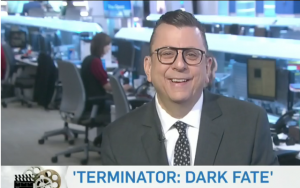CP24: RICHARD ON BRUCE WILLIS’S RETIREMENT ANNOUNCEMENT
 Richard joins CP24 host Shanelle Kaul to discuss the shocking announcement of Bruce Willis’s retirement.
Richard joins CP24 host Shanelle Kaul to discuss the shocking announcement of Bruce Willis’s retirement.
Watch the whole thing HERE!
 Richard joins CP24 host Shanelle Kaul to discuss the shocking announcement of Bruce Willis’s retirement.
Richard joins CP24 host Shanelle Kaul to discuss the shocking announcement of Bruce Willis’s retirement.
Watch the whole thing HERE!
 Richard and NewsTalk 1010’s The Rush host Jim Richards talk about Bruce Willis and his retirement.
Richard and NewsTalk 1010’s The Rush host Jim Richards talk about Bruce Willis and his retirement.
Listen to the whole thing HERE!
 Richard speaks to “CTV News at 11:30” anchor Andria Case about television and movies to watch during the pandemic including some new movies on VOD including darkly comedic revenge story “Judy and Punch,” the home invasion “thriller” “Survive the Night” and the eco doc “2040.”
Richard speaks to “CTV News at 11:30” anchor Andria Case about television and movies to watch during the pandemic including some new movies on VOD including darkly comedic revenge story “Judy and Punch,” the home invasion “thriller” “Survive the Night” and the eco doc “2040.”
Watch the whole thing HERE!
 Richard and CTV NewsChannel anchor Andrea Bain talk about the latest movies coming to VOD and streaming services, including the darkly comedic revenge story “Judy and Punch,” the Hitchschlockian thrills of “Last Moment of Clarity,” a pair of home invasion movies, “Survive the Night” and “Becky” and the eco doc “2040.”
Richard and CTV NewsChannel anchor Andrea Bain talk about the latest movies coming to VOD and streaming services, including the darkly comedic revenge story “Judy and Punch,” the Hitchschlockian thrills of “Last Moment of Clarity,” a pair of home invasion movies, “Survive the Night” and “Becky” and the eco doc “2040.”
Watch the whole thing HERE!
 Richard sits in on the CFRA Ottawa morning show with host Bill Carroll to talk the new movies coming to VOD and streaming services including the darkly comedic revenge story “Judy and Punch,” the Hitchschlockian thrills of “Last Moment of Clarity,” a pair of home invasion movies, “Survive the Night” and “Becky” and the eco doc “2040.”
Richard sits in on the CFRA Ottawa morning show with host Bill Carroll to talk the new movies coming to VOD and streaming services including the darkly comedic revenge story “Judy and Punch,” the Hitchschlockian thrills of “Last Moment of Clarity,” a pair of home invasion movies, “Survive the Night” and “Becky” and the eco doc “2040.”
Listen to the whole thing HERE!
 The idea of stalling for time in a bad situation makes perfect sense in real life. In “Survive the Night,” a new home invasion film now on VOD, a disgraced doctor tries to buy time to protect his family as some very bad men hold them hostage. Trouble is, it’s a movie, and his stalling techniques bring the action in this plodding thriller to a dead stop.
The idea of stalling for time in a bad situation makes perfect sense in real life. In “Survive the Night,” a new home invasion film now on VOD, a disgraced doctor tries to buy time to protect his family as some very bad men hold them hostage. Trouble is, it’s a movie, and his stalling techniques bring the action in this plodding thriller to a dead stop.
“One Tree Hill” star Chad Michael Murray is Rich, a doctor whose once-promising career was cut short by a malpractice suit. “I cut when I should have stitched or stitched when I should have cut,” he says. “I don’t even know!” Disgraced, he now lives on a remote farm with his parents, (Bruce Willis and Jessica Abrams), his wife (Lydia Hull) and their teenage daughter (Riley Wolfe Rach) and works at a small clinic, patching up injured farmers.
It’s there that Jamie (Shea Buckner), a low-level crook with impulse control, first sees the doc and hatches the plan to invade Rich’s home and get some much-needed medical treatment for his brother Mathias (Tyler Jon Olson). If Rich doesn’t operate, Jamie promises to fill the family with lead. Rich fears that if he operates and Matthias dies, chaos will ensue.
Cue the stall tactics.
The suspense free plot of “Survive the Night”—which should really have been titled “Survive the Night and Most of the Next Morning”—relies on characters doing unrealistic and just plain stupid things in almost every scene. If you took a drink every time Rich did something that only made his situation worse, you’d be hammered by the second act. Or, if you’re not a drinker, take a sip every time Bruce Willis looks like he’s happy to be part of this movie. You’ll be stone cold sober as the end credits run.
“Survive the Night” is the rare “thriller” where you don’t root for anyone, the heroes or villains. Even a car chase goes nowhere… literally and figuratively. It’s like a thriller made by people who have never actually seen a thriller and who based this one on stuff their friends told them about “Panic Room” and “Funny Games.”
 Richard joins CP24 to have a look at the weekend’s new movies including the direct sequel to 1991’s “T2,” “Terminator: Dark Fate,” “Harriet,” the inspiring life story of American abolitionist and political activist Harriet Tubman and the Edward Norton noir “Motherless Brooklyn.”
Richard joins CP24 to have a look at the weekend’s new movies including the direct sequel to 1991’s “T2,” “Terminator: Dark Fate,” “Harriet,” the inspiring life story of American abolitionist and political activist Harriet Tubman and the Edward Norton noir “Motherless Brooklyn.”
Watch the whole thing HERE!
 Richard sits in on the CTV NewsChannel with news anchor Lois Lee to have a look at the weekend’s big releases including the reunion of Linda Hamilton and Arnold Schwarzenegger in “Terminator: Dark Fate,” the biopic “Harriet” starring Cynthia Erivo and “Motherless Brooklyn” from star, director, producer and writer Edward Norton.
Richard sits in on the CTV NewsChannel with news anchor Lois Lee to have a look at the weekend’s big releases including the reunion of Linda Hamilton and Arnold Schwarzenegger in “Terminator: Dark Fate,” the biopic “Harriet” starring Cynthia Erivo and “Motherless Brooklyn” from star, director, producer and writer Edward Norton.
Watch the whole thing HERE!
 Richard has a look at the new movies coming to theatres, including the direct sequel to 1991’s “T2,” “Terminator: Dark Fate,” “Harriet,” the inspiring life story of American abolitionist and political activist Harriet Tubman and the Edward Norton noir “Motherless Brooklyn” with CFRA morning show host Bill Carroll.
Richard has a look at the new movies coming to theatres, including the direct sequel to 1991’s “T2,” “Terminator: Dark Fate,” “Harriet,” the inspiring life story of American abolitionist and political activist Harriet Tubman and the Edward Norton noir “Motherless Brooklyn” with CFRA morning show host Bill Carroll.
Listen to the whole thing HERE!